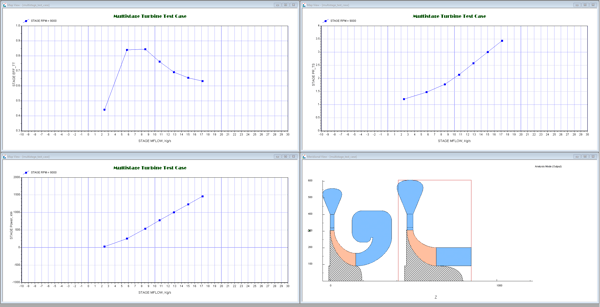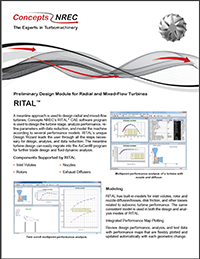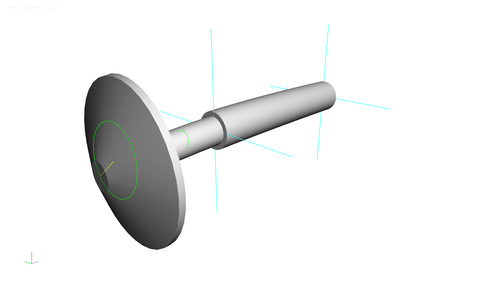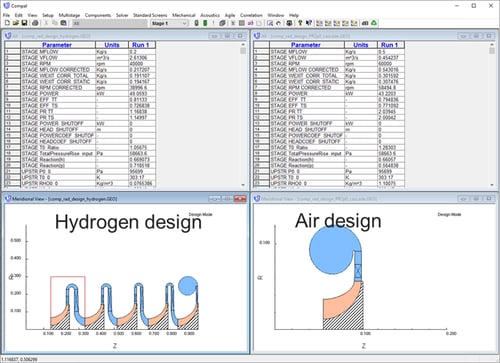RITAL™
CAE Software for Radial Turbine Design
A meanline approach is used to design radial and mixed-inflow turbines. RITAL™ is used to design the turbine stage, analyze performance, refine parameters with data reduction, and model the machine according to several performance models. RITAL's unique Design Wizard leads the user through all the steps necessary for design, analysis, and data reduction. The meanline turbine design can easily migrate into the AxCent® program for further blade design and fluid dynamic analysis.
Components Supported by RITAL:
- Inlet volutes
- Nozzles
- Rotors
- Exhaust diffusers
Modeling
RITAL has built-in models for inlet volutes, rotor and nozzle diffusion/losses, disk friction, and other losses related to subsonic turbine performance. The same consistent model is used in both the design and analysis modes of RITAL.
Integrated Performance Map Plotting
Review design performance, analysis, and test data with flexibly plotted performance maps, updated automatically with each geometric change.
Easy Editing
View the turbine stage in an active, true-scale meridional view. Edit the parameters by double clicking on the component in the meridional view. Also edit parameters using a single text input/output file, a feature especially useful for optimization.
Table View of Results
View the results in a flexible, spreadsheet-like table format, customizable through separate filters. Create any number of filters, select what to display, and customize the labels as well.
Axial View with Velocity Triangles
Using the window view, view blades and velocity triangles at the impeller inlet and exit.
OLE Automation Support
Control RITAL from an external program through industry-standard Object Linking and Embedding (OLE) automation. OLE automation supports full control of data entry, program execution, and result retrieval. External programs can be written in Visual Basic, C++, FORTRAN, or any other language which supports the Microsoft® OLE standard.
A Real Fluid Program
RITAL calculates Real Fluid properties using optional DB Robinson Real Fluid Properties, NIST, or ASME Steam routines. Users can also incorporate their own proprietary fluid properties.
Direct Integration with AxCent®
Start AxCent automatically from inside RITAL, which automatically transfers the initial geometry to AxCent for 3D geometry generation, rapid loading analysis, throughflow analysis, and output for CFD and FEA stress analysis. Changes in AxCent that affect the meanline analysis will cause the meanline analysis to be rerun and all performance maps to be regenerated.
Output to AxCent®
RITAL supports the Agile Engineering Design System® process through easy transfer of meanline design information to the AxCent program for geometry generation, rapid loading analysis, throughflow analysis, and output to CFD and FEA programs.

Software Highlights
-
-
Inlet volutes
-
Nozzles
-
Rotors
-
Exhaust diffusers
-
-
RITAL has built-in models for inlet volutes, rotor and nozzle diffusion/losses, disk friction, and other losses related to subsonic turbine performance. The same consistent model is used in both the design and analysis modes of RITAL.
-
Review design performance, analysis, and test data with flexibly plotted performance maps, updated automatically with each geometric change.
-
View the turbine stage in an active, true-scale meridional view. Edit the parameters by double clicking on the component in the meridional view. Also edit parameters using a single text input/output file, a feature especially useful for optimization.
-
View the results in a flexible, spreadsheet-like table format, customizable through separate filters. Create any number of filters, select what to display, and customize the labels as well.
-
Using the window view, view blades and velocity triangles at the impeller inlet and exit.
-
Control RITAL from an external program through industry-standard Object Linking and Embedding (OLE) automation. OLE automation supports full control of data entry, program execution, and result retrieval. External programs can be written in Visual Basic, C++, FORTRAN, or any other language which supports the Microsoft® OLE standard.
-
RITAL calculates Real Fluid properties using optional DB Robinson Real Fluid Properties, NIST, or ASME Steam routines. Users can also incorporate their own proprietary fluid properties.
-
Start AxCent automatically from inside RITAL, which automatically transfers the initial geometry to AxCent for 3D geometry generation, rapid loading analysis, throughflow analysis, and output for CFD and FEA stress analysis. Changes in AxCent that affect the meanline analysis will cause the meanline analysis to be rerun and all performance maps to be regenerated.
-
RITAL supports the Agile Engineering Design System® process through easy transfer of meanline design information to the AxCent program for geometry generation, rapid loading analysis, throughflow analysis, and output to CFD and FEA programs.
-
Inlet volutes
-
Nozzles
-
Rotors
-
Exhaust diffusers
RITAL has built-in models for inlet volutes, rotor and nozzle diffusion/losses, disk friction, and other losses related to subsonic turbine performance. The same consistent model is used in both the design and analysis modes of RITAL.
Review design performance, analysis, and test data with flexibly plotted performance maps, updated automatically with each geometric change.
View the turbine stage in an active, true-scale meridional view. Edit the parameters by double clicking on the component in the meridional view. Also edit parameters using a single text input/output file, a feature especially useful for optimization.
View the results in a flexible, spreadsheet-like table format, customizable through separate filters. Create any number of filters, select what to display, and customize the labels as well.
Using the window view, view blades and velocity triangles at the impeller inlet and exit.
Control RITAL from an external program through industry-standard Object Linking and Embedding (OLE) automation. OLE automation supports full control of data entry, program execution, and result retrieval. External programs can be written in Visual Basic, C++, FORTRAN, or any other language which supports the Microsoft® OLE standard.
RITAL calculates Real Fluid properties using optional DB Robinson Real Fluid Properties, NIST, or ASME Steam routines. Users can also incorporate their own proprietary fluid properties.
Start AxCent automatically from inside RITAL, which automatically transfers the initial geometry to AxCent for 3D geometry generation, rapid loading analysis, throughflow analysis, and output for CFD and FEA stress analysis. Changes in AxCent that affect the meanline analysis will cause the meanline analysis to be rerun and all performance maps to be regenerated.
RITAL supports the Agile Engineering Design System® process through easy transfer of meanline design information to the AxCent program for geometry generation, rapid loading analysis, throughflow analysis, and output to CFD and FEA programs.
Components Supported by RITAL
-
Inlet volutes
-
Nozzles
-
Rotors
-
Exhaust diffusers
Modeling
RITAL has built-in models for inlet volutes, rotor and nozzle diffusion/losses, disk friction, and other losses related to subsonic turbine performance. The same consistent model is used in both the design and analysis modes of RITAL.
Integrated Performance Map Plotting
Review design performance, analysis, and test data with flexibly plotted performance maps, updated automatically with each geometric change.
Easy Editing
View the turbine stage in an active, true-scale meridional view. Edit the parameters by double clicking on the component in the meridional view. Also edit parameters using a single text input/output file, a feature especially useful for optimization.
Table View of Results
View the results in a flexible, spreadsheet-like table format, customizable through separate filters. Create any number of filters, select what to display, and customize the labels as well.
Axial View with Velocity Triangles
Using the window view, view blades and velocity triangles at the impeller inlet and exit.
OLE Automation Support
Control RITAL from an external program through industry-standard Object Linking and Embedding (OLE) automation. OLE automation supports full control of data entry, program execution, and result retrieval. External programs can be written in Visual Basic, C++, FORTRAN, or any other language which supports the Microsoft® OLE standard.
A Real Fluid Program
RITAL calculates Real Fluid properties using optional DB Robinson Real Fluid Properties, NIST, or ASME Steam routines. Users can also incorporate their own proprietary fluid properties.
Direct Integration with AxCent
Start AxCent automatically from inside RITAL, which automatically transfers the initial geometry to AxCent for 3D geometry generation, rapid loading analysis, throughflow analysis, and output for CFD and FEA stress analysis. Changes in AxCent that affect the meanline analysis will cause the meanline analysis to be rerun and all performance maps to be regenerated.
Output to AxCent
RITAL supports the Agile Engineering Design System® process through easy transfer of meanline design information to the AxCent program for geometry generation, rapid loading analysis, throughflow analysis, and output to CFD and FEA programs.
Product Support

Customer-driven Improvement

Technical Support

Documentation

Multi-Stage Turbine Design
RITAL Brochure
A meanline approach is used to design radial and mixed-flow turbines, Concepts NREC’s RITAL™ CAE software program is used to design the turbine stage, analyze performance, refine parameters with data reduction, and model the machine according to several performance models. RITAL’s unique Design Wizard leads the user through all the steps necessary for design, analysis, and data reduction. The meanline turbine design can easily migrate into the AxCent® program
for further blade design and fluid dynamic analysis.

Find Your Rep
Our Sales Offices are strategically located around the globe to service all your turbomachinery needs.
Corporate Headquarters
217 Billings Farm Road
White River Junction, VT 05001-9486
Phone: 802-296-2321
Fax: 802-296-2325
Email: sales@conceptsnrec.com
North America Software Sales
Phone: 802-280-6181
Fax: 802-296-2325
Email: droberson@conceptsnrec.com
Upcoming Events
Tradeshows, Workshops, Webinars and more.
2021 Online Centrifugal and Axial Pumps Course - Modern Design, Performance, and Problem Solving
Application-Based Learning
Date: October 18 - 29, 2021
Time: 9:30 am - 1:00 pm EDT
Course Fee: $3500 USD
This course is designed to help engineers design, test, and run pumps and systems that are more efficient, more economical, and more reliable. Engineers will come to understand the best state-of-the-art design practices and learn the latest theories on performance, cavitation, dynamic forces, and noise. The course will review the latest advances in design tools and will provide expert and relevant instruction to designers on pump design optimization. Nearly half of all the teaching is focused on actual commercial design cases with measured data for confirmation.
2021 Trade Show: ComVac Asia
Visit Concepts NREC China at the ComVac Asia
Date: October 26-29, 2021
Location: Shanghai, China
To learn more, visit https://www.comvac-asia.com/index.php?lang=en
I came to the realization that we needed some objective insight.
We were working well with the OEM but even with our combined efforts, we were struggling to get a critical compressor to pass performance on their test stand. Although I'd never directly done business with Concepts NREC I was familiar with them and their capability so I chose to contact them when I came to the realization that we needed some objective insight. Concepts NREC fielded my cold call and immediately engaged their expertise in a complex problem that was also challenged by schedule constraints. They provided increased understanding of an already complex CFD which resulted in increased confidence that the proposed solution would succeed on the next test stand attempt (which it did!). We are pleased to have had the help of Concepts NREC and now have a well-performing compressor in our process.”
Bryan Barrington
Senior Advisor - Machinery Engineering




